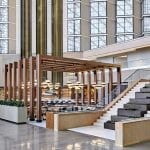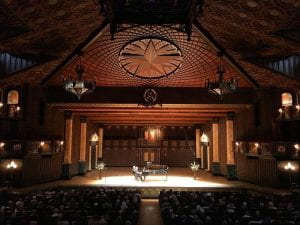Aaron Copland in 1961
In 1974-5, I had the remarkable opportunity to meet and have a lesson with the legendary composer Aaron Copland. At that time, I was immersed in my music studies, completing my undergraduate degree and embarking on my graduate studies. Although I had taken an extra year to finish my undergraduate degree to focus on a recital, I had already accumulated 15 graduate hours towards my Master’s degree. My musical activities were diverse and engaging. I had delved into the extensive piano repertoire of Igor Stravinsky, performing works such as the piano/violin duo version of “L’Histoire du Soldat” on a mini-concert tour. I had also played Three Movt. from “Petrouchka” for James Dick, declined his invitation to be his student, and explored the thrilling 2-piano version of “The Rite of Spring,” arranged by Stravinsky himself, with Tom Wells.
During that time, I was privileged to serve as the director of the New Music Ensemble, which had found a permanent performance space in the Art School surrounded by contemporary art and sculptures. Additionally, I had the opportunity to explore jazz and Middle Eastern music in a band led by the now-conductor Howard Hudiburg. My composition teacher was Karl Korte, who has remained a respected figure in the music world. As a teaching assistant, I had the honor of working with Kent Kennan, who had orchestrated Igor Stravinsky’s visit to Austin in 1967, although I had been in high school and unaware of the great composer at that time.
It was through Karl Korte’s friendship with Aaron Copland that I found myself in a truly unforgettable experience. Copland had arrived in Austin to conduct a performance with the Austin Symphony, and Korte invited him for a luncheon at the Erle Stanley Gardner room in the Academic Center of our school. Only a select few professors were present, and I was asked to attend because I was currently preparing Copland’s Piano Fantasy for performance.
The moment Mr. Copland entered the room at noon, his radiant smile, vibrant energy, and impeccably dressed appearance immediately caught everyone’s attention. After the introductions and handshakes, he approached me with genuine interest and asked me to introduce myself. I humbly stated that I was a student studying piano and composition and that I would be performing his Piano Fantasy. Showing his characteristic enthusiasm, Copland requested that I play it for him, and although I felt a mix of nerves and excitement, I agreed.
Following the luncheon, the group made its way from the Academic Center to the old music building, hastily preparing a large classroom on the second floor for the impromptu performance. Whether it was Copland’s suggestion or a collective assumption, the gathering unexpectedly turned into a private one-on-one lesson. While I can’t recall precisely which sections of the Piano Fantasy I performed, I must admit that my understanding of the piece at that time was quite limited. Nevertheless, Copland’s insightful questions and guidance during our interaction revealed new layers of the composition to me.
At one point, Copland inquired about my passions and interests, and when I mentioned my love for jazz, his eyes gleamed with excitement. He shared his own affinity for jazz and encouraged me to play some for him. Without hesitation, I launched into an F blues, followed by Miles Davis’s iconic tune “So What,” and perhaps a fragment of a ballad, most likely “Stella by Starlight.” Copland’s infectious enthusiasm and warm encouragement instilled a newfound confidence in me. He emphasized the importance of pursuing my dreams and continuing to work diligently.
As our lesson progressed, a mention of Copland’s scheduled rehearsal that afternoon abruptly interrupted our time together. Recognizing the need for him to depart, the lesson came to an abrupt end. However, what remains etched in my memory to this day is the sheer energy in Copland’s speech, his comfortable and engaging conversational style, and the genuine focus he bestowed upon me during our encounter. His willingness to spend time and offer personal inspiration has left an indelible mark on my musical journey.
Reflecting on that experience, I realize that I have subconsciously adopted Copland’s approach in my own teaching today. I strive to provide my students with the same attention, encouragement, and belief in their potential that Copland so generously shared with me. I am immensely grateful for the privilege of meeting Aaron Copland and cherish the lasting impact he has had on my life and career.
Posted by © Time/Space Fabrics

 Just behind him his tour bus was unloading, and his entire big band was checking in to hotel rooms. Dizzy said, “Keep it goin’!” One of my favorite tunes by Dizzy is Con Alma so I played it. Much to my surprise one of the guys pulled out his flute and played with me. Soon several guys sat down in the bar to listen. We got to talking and they were playing that night at the Paramount.
Just behind him his tour bus was unloading, and his entire big band was checking in to hotel rooms. Dizzy said, “Keep it goin’!” One of my favorite tunes by Dizzy is Con Alma so I played it. Much to my surprise one of the guys pulled out his flute and played with me. Soon several guys sat down in the bar to listen. We got to talking and they were playing that night at the Paramount.

 It was a Monday or a Tuesday, about midnight, when Jack Lemmon and his manager came in for drinks. They sat a couple tables away, and I noticed that Jack Lemmon was really listening to everything I was doing. He smiled and we didn’t say anything, and I was done at 1AM. Then next night they were back again, sitting right in front of me. Smoking was still allowed back then, and they would talk and listen, drink and smoke. When I played solo piano back then, I had a couple hundred tunes in my repertoire, including all the Gershwin, Cole Porter, Jerome Kern, Harold Arlen, Johnny Mercer, Richard Rodgers, and Irving Berlin standards. I had my Bill Evans style down and I was totally into playing these tunes well, and getting well paid. This was, for a pianist, the very best gig in Austin.
It was a Monday or a Tuesday, about midnight, when Jack Lemmon and his manager came in for drinks. They sat a couple tables away, and I noticed that Jack Lemmon was really listening to everything I was doing. He smiled and we didn’t say anything, and I was done at 1AM. Then next night they were back again, sitting right in front of me. Smoking was still allowed back then, and they would talk and listen, drink and smoke. When I played solo piano back then, I had a couple hundred tunes in my repertoire, including all the Gershwin, Cole Porter, Jerome Kern, Harold Arlen, Johnny Mercer, Richard Rodgers, and Irving Berlin standards. I had my Bill Evans style down and I was totally into playing these tunes well, and getting well paid. This was, for a pianist, the very best gig in Austin. What I will always remember, is that at one point Jack Lemmon looked me straight in the eye, and said. “I’d give this all up, if I could play like that!” I was taken aback. I said, “Jack, you have the adoration of millions of people, who love everything you’ve done in the movies, and you’re a world class actor. How can you say that?” He said, “Acting’s easy. I’m really a frustrated jazz piano player.” I said, “the grass is always greener on the other side of the fence. You have the awards, and acclaim from all your peers. You don’t need anymore.”
What I will always remember, is that at one point Jack Lemmon looked me straight in the eye, and said. “I’d give this all up, if I could play like that!” I was taken aback. I said, “Jack, you have the adoration of millions of people, who love everything you’ve done in the movies, and you’re a world class actor. How can you say that?” He said, “Acting’s easy. I’m really a frustrated jazz piano player.” I said, “the grass is always greener on the other side of the fence. You have the awards, and acclaim from all your peers. You don’t need anymore.” On his last night, Jack Lemmon left me an enormous tip. I tried to turn him down, but he wouldn’t think of it. We left like we were friends for life. And I am so happy this happened to me. Thanks, Jack!
On his last night, Jack Lemmon left me an enormous tip. I tried to turn him down, but he wouldn’t think of it. We left like we were friends for life. And I am so happy this happened to me. Thanks, Jack!
 Last night in Round Top, Texas, at the 16th Annual “Poetry at Round Top”, John Mills and I joined the nation’s most exciting and prominent poets for an evening of collaboration in art.
Last night in Round Top, Texas, at the 16th Annual “Poetry at Round Top”, John Mills and I joined the nation’s most exciting and prominent poets for an evening of collaboration in art. So want happens when poetry, composition, and jazz are asked to collaborate? The history goes back to the 40’s and 50’s American Beat poets like Jack Kerouac, for example. We viewed the music as a support and an intensifier to the poetry rather than the poetry’s being an addendum (or introduction) to the music.
So want happens when poetry, composition, and jazz are asked to collaborate? The history goes back to the 40’s and 50’s American Beat poets like Jack Kerouac, for example. We viewed the music as a support and an intensifier to the poetry rather than the poetry’s being an addendum (or introduction) to the music. In the 1980’s, I played piano non-stop for corporations, grand openings, and big gala events.
In the 1980’s, I played piano non-stop for corporations, grand openings, and big gala events.






 They really have me working this time! 🙂
They really have me working this time! 🙂